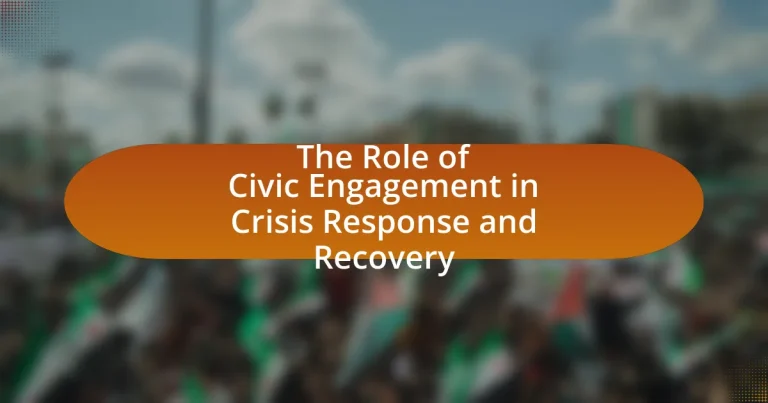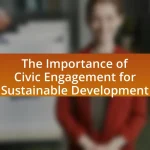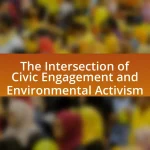Civic engagement is a vital component in crisis response and recovery, significantly enhancing community resilience and facilitating effective communication among stakeholders. Engaged citizens play a crucial role in identifying needs, mobilizing resources, and implementing solutions during crises, as evidenced by their contributions during events like the COVID-19 pandemic and Hurricane Katrina. Key components of civic engagement include community mobilization, information dissemination, collaboration with local authorities, and volunteerism, all of which are essential for effective crisis management. The article explores the mechanisms of civic engagement, the impact of social media, the challenges faced, and best practices for enhancing participation, ultimately highlighting the importance of active citizen involvement in fostering resilience and improving recovery outcomes.
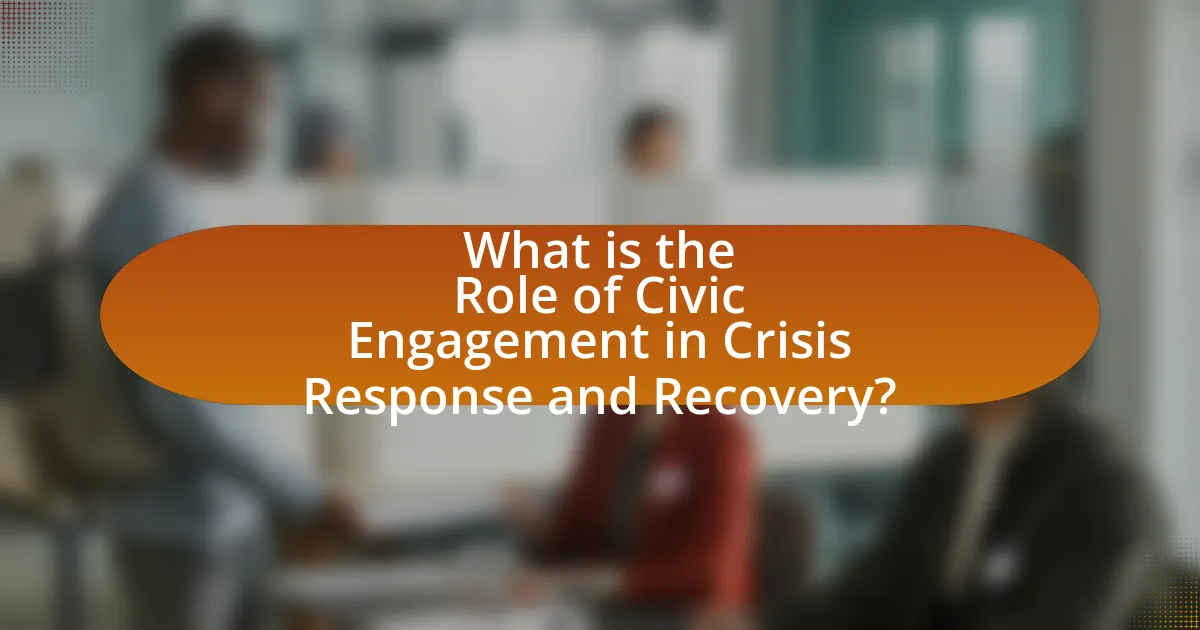
What is the Role of Civic Engagement in Crisis Response and Recovery?
Civic engagement plays a crucial role in crisis response and recovery by fostering community resilience and facilitating effective communication among stakeholders. Engaged citizens contribute to identifying needs, mobilizing resources, and implementing solutions during crises, which enhances the overall effectiveness of response efforts. For instance, during the COVID-19 pandemic, community organizations and volunteers were instrumental in distributing food and medical supplies, demonstrating how civic participation can directly impact recovery outcomes. Research from the National Academy of Sciences indicates that communities with higher levels of civic engagement experience faster recovery times and improved mental health outcomes post-crisis, underscoring the importance of active citizen involvement in these processes.
How does civic engagement influence crisis response efforts?
Civic engagement significantly enhances crisis response efforts by fostering community collaboration and resource mobilization. When citizens actively participate in local governance and emergency planning, they contribute valuable insights and local knowledge that improve the effectiveness of response strategies. For instance, during Hurricane Katrina, community organizations played a crucial role in coordinating relief efforts, demonstrating that engaged citizens can facilitate faster and more efficient aid distribution. Furthermore, research from the National Academy of Sciences indicates that communities with higher levels of civic engagement experience better preparedness and resilience during crises, as engaged citizens are more likely to volunteer, share information, and support one another in times of need.
What are the key components of civic engagement in crisis situations?
The key components of civic engagement in crisis situations include community mobilization, information dissemination, collaboration with local authorities, and volunteerism. Community mobilization involves organizing residents to respond effectively to crises, as seen in grassroots movements during natural disasters. Information dissemination ensures that accurate and timely information reaches the public, which is crucial for effective response; for example, during the COVID-19 pandemic, community organizations played a vital role in sharing health guidelines. Collaboration with local authorities enhances the effectiveness of response efforts, as evidenced by partnerships between NGOs and government agencies in disaster relief operations. Lastly, volunteerism encourages individuals to contribute their time and skills, significantly impacting recovery efforts, as demonstrated by the thousands of volunteers who assisted in recovery after Hurricane Katrina.
How do community organizations contribute to civic engagement during crises?
Community organizations enhance civic engagement during crises by mobilizing resources, facilitating communication, and fostering collaboration among residents. These organizations often serve as trusted intermediaries, providing critical information and support to affected individuals, which encourages community participation in recovery efforts. For example, during the COVID-19 pandemic, local organizations coordinated food distribution and health resources, significantly increasing community involvement in public health initiatives. Research indicates that communities with active organizations experienced higher levels of volunteerism and civic participation, demonstrating their vital role in crisis response and recovery.
Why is civic engagement important for recovery after a crisis?
Civic engagement is crucial for recovery after a crisis because it fosters community resilience and facilitates effective resource allocation. Engaged citizens contribute to rebuilding efforts by sharing information, mobilizing resources, and supporting one another, which enhances the overall recovery process. For instance, during the aftermath of Hurricane Katrina, community organizations and volunteers played a significant role in providing immediate assistance and long-term recovery solutions, demonstrating that active participation leads to more effective and sustainable outcomes.
What role do volunteers play in the recovery process?
Volunteers play a crucial role in the recovery process by providing essential support and resources to affected communities. They assist in various activities such as distributing food, offering emotional support, and helping with rebuilding efforts. For instance, during the aftermath of natural disasters, organizations like the American Red Cross rely heavily on volunteers to deliver services and aid, demonstrating that volunteer involvement can significantly enhance the efficiency and effectiveness of recovery operations. Research indicates that communities with active volunteer networks recover more quickly and effectively, as volunteers help bridge gaps in professional services and foster community resilience.
How does civic engagement foster resilience in communities?
Civic engagement fosters resilience in communities by promoting social cohesion and collective problem-solving. When individuals actively participate in community activities, they build trust and relationships, which are essential during crises. Research indicates that communities with higher levels of civic engagement are better equipped to respond to and recover from disasters, as seen in the aftermath of Hurricane Katrina, where neighborhoods with strong social networks demonstrated quicker recovery times. Additionally, civic engagement encourages diverse perspectives, leading to innovative solutions that enhance community preparedness and adaptability.
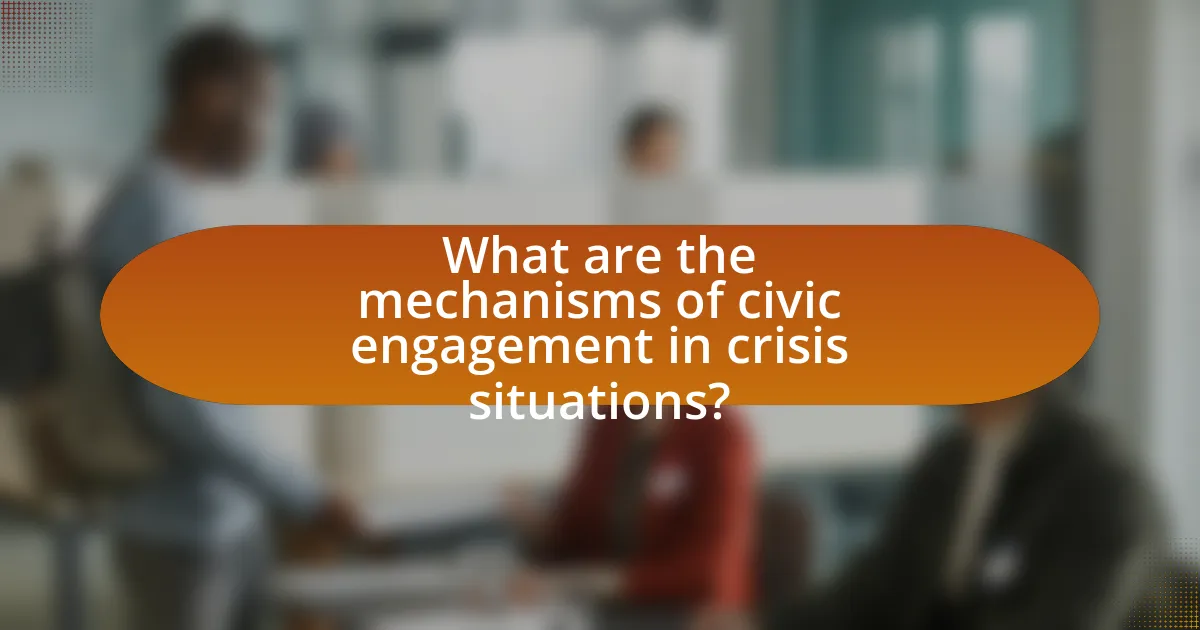
What are the mechanisms of civic engagement in crisis situations?
Civic engagement in crisis situations primarily occurs through mechanisms such as community organizing, volunteerism, advocacy, and collaboration with local authorities. Community organizing mobilizes individuals to address immediate needs and coordinate resources effectively, as seen in grassroots movements during natural disasters. Volunteerism enables citizens to provide direct assistance, exemplified by organizations like the Red Cross, which rely on volunteers during emergencies. Advocacy efforts raise awareness and influence policy decisions, demonstrated by campaigns that push for better disaster preparedness legislation. Collaboration with local authorities ensures that community needs are met efficiently, as evidenced by partnerships formed during public health crises like the COVID-19 pandemic, where local governments worked with community groups to disseminate information and resources. These mechanisms collectively enhance resilience and facilitate effective responses in times of crisis.
How do social media platforms facilitate civic engagement during crises?
Social media platforms facilitate civic engagement during crises by providing real-time communication channels that enable individuals and organizations to share information, mobilize resources, and coordinate responses. For instance, during natural disasters like Hurricane Harvey in 2017, platforms such as Twitter and Facebook were used to disseminate urgent updates, organize volunteer efforts, and connect those in need with available assistance. Research indicates that 70% of social media users reported using these platforms to seek information during crises, highlighting their role as vital tools for community engagement and support.
What are the advantages of using social media for crisis communication?
The advantages of using social media for crisis communication include rapid information dissemination, real-time engagement, and broad reach. Social media platforms allow organizations to quickly share updates and critical information during a crisis, ensuring that the public receives timely alerts. For instance, during natural disasters, agencies like FEMA utilize Twitter to provide immediate updates, which can significantly reduce confusion and misinformation. Additionally, social media facilitates two-way communication, enabling organizations to engage with the public, address concerns, and gather feedback, which enhances community trust and collaboration. Furthermore, the extensive user base of platforms like Facebook and Instagram allows messages to reach a diverse audience, maximizing the impact of communication efforts during crises.
How can misinformation be managed on social media during crises?
Misinformation can be managed on social media during crises by implementing fact-checking mechanisms, promoting media literacy, and enhancing collaboration between platforms and credible organizations. Fact-checking mechanisms, such as partnerships with independent fact-checkers, can help identify and label false information quickly, as seen during the COVID-19 pandemic when platforms like Facebook and Twitter increased their fact-checking efforts. Promoting media literacy equips users with skills to critically evaluate information sources, which has been shown to reduce the spread of misinformation. Additionally, collaboration between social media platforms and credible organizations, such as public health agencies, ensures that accurate information is disseminated effectively, as evidenced by initiatives like the WHO’s collaboration with social media companies to combat misinformation during health crises.
What formal structures support civic engagement in crisis response?
Formal structures that support civic engagement in crisis response include government agencies, non-governmental organizations (NGOs), and community-based organizations. These entities facilitate communication, coordination, and resource allocation during crises. For instance, the Federal Emergency Management Agency (FEMA) in the United States collaborates with local governments and NGOs to enhance community resilience and engagement through programs like Community Rating System, which incentivizes local preparedness efforts. Additionally, organizations such as the Red Cross mobilize volunteers and resources, demonstrating the effectiveness of structured civic participation in disaster response.
How do local governments collaborate with civic organizations?
Local governments collaborate with civic organizations through partnerships that enhance community engagement and resource sharing. These collaborations often involve joint initiatives, such as disaster preparedness programs, where local governments provide funding and logistical support while civic organizations mobilize volunteers and community outreach efforts. For instance, during the COVID-19 pandemic, many local governments worked with civic organizations to distribute food and medical supplies, demonstrating effective coordination in crisis response. This partnership model not only strengthens community resilience but also leverages the unique strengths of both entities to address local needs efficiently.
What policies enhance civic participation in emergency management?
Policies that enhance civic participation in emergency management include community engagement initiatives, public education programs, and collaborative planning frameworks. Community engagement initiatives, such as local advisory boards and public forums, empower citizens to voice their concerns and contribute to decision-making processes. Public education programs inform residents about emergency preparedness and response, fostering a culture of proactive involvement. Collaborative planning frameworks, like partnerships between government agencies and community organizations, facilitate shared responsibility and resource allocation during crises. These policies are supported by research indicating that increased civic participation leads to more effective emergency responses and improved community resilience. For instance, a study by the Federal Emergency Management Agency (FEMA) highlights that communities with active civic engagement experience faster recovery times and better resource management during disasters.
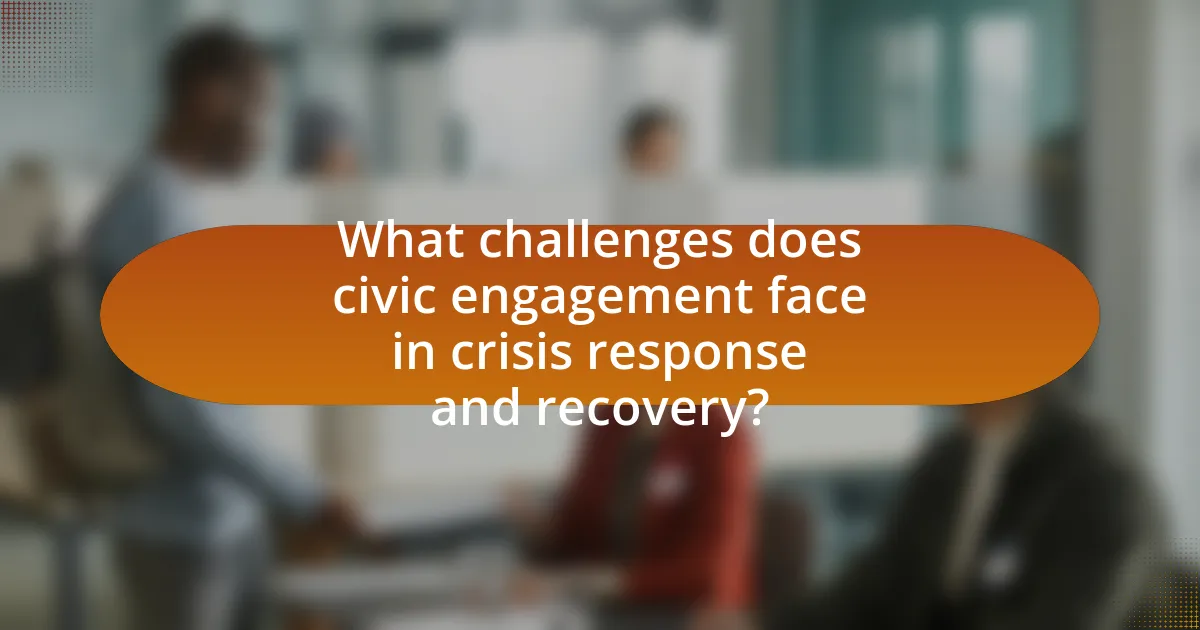
What challenges does civic engagement face in crisis response and recovery?
Civic engagement faces several challenges in crisis response and recovery, including communication barriers, resource limitations, and public trust issues. Communication barriers arise when information is not effectively disseminated to communities, leading to misinformation and confusion during crises. Resource limitations hinder the ability of civic organizations to mobilize effectively, as they often lack funding, personnel, and logistical support necessary for impactful engagement. Additionally, public trust issues can undermine civic participation; if communities do not trust the institutions or organizations involved in crisis response, they are less likely to engage or cooperate. These challenges can significantly impede the effectiveness of civic engagement efforts in addressing crises and facilitating recovery.
What barriers hinder effective civic engagement during crises?
Barriers that hinder effective civic engagement during crises include lack of access to information, limited communication channels, and social inequalities. During crises, individuals often struggle to obtain timely and accurate information, which is crucial for informed participation. For instance, research by the Pew Research Center indicates that 53% of Americans feel overwhelmed by the amount of information available during emergencies, leading to confusion and disengagement. Additionally, communication channels may be disrupted, making it difficult for communities to organize and mobilize effectively. Social inequalities, such as economic disparities and marginalized communities lacking resources, further exacerbate these barriers, as these groups may face greater challenges in accessing civic engagement opportunities.
How do socioeconomic factors impact civic participation in crisis situations?
Socioeconomic factors significantly impact civic participation in crisis situations by influencing individuals’ resources, access to information, and social networks. Individuals from higher socioeconomic backgrounds typically possess greater financial resources, education, and social capital, enabling them to engage more effectively in civic activities during crises. For instance, research by the Pew Research Center indicates that individuals with higher income levels are more likely to volunteer and participate in community organizations during emergencies. Conversely, those from lower socioeconomic backgrounds may face barriers such as lack of time due to multiple jobs, limited access to information about civic opportunities, and weaker social networks, which can hinder their participation. This disparity in engagement can lead to unequal representation in crisis response efforts, ultimately affecting the effectiveness of recovery initiatives.
What role does trust play in community engagement during emergencies?
Trust is essential for effective community engagement during emergencies, as it fosters cooperation and facilitates communication among community members and response agencies. When trust exists, individuals are more likely to share critical information, adhere to safety guidelines, and participate in recovery efforts. Research indicates that communities with high levels of trust experience quicker recovery times and more effective disaster response, as seen in the aftermath of Hurricane Katrina, where trust in local organizations significantly influenced community resilience and engagement.
How can these challenges be overcome to enhance civic engagement?
To enhance civic engagement, challenges can be overcome by implementing targeted educational programs that inform citizens about their rights and responsibilities. Research indicates that communities with higher levels of civic education experience increased participation in local governance and decision-making processes. For instance, a study by the National Civic League found that municipalities that invested in civic education initiatives saw a 30% increase in voter turnout and community involvement during crises. Additionally, leveraging technology to facilitate communication and collaboration among citizens can further enhance engagement, as evidenced by the success of online platforms that mobilize community action during emergencies.
What best practices can be implemented to improve civic engagement in crises?
To improve civic engagement in crises, best practices include fostering transparent communication, utilizing technology for outreach, and building partnerships with community organizations. Transparent communication ensures that citizens receive timely and accurate information, which is crucial during crises; for instance, studies show that communities with clear communication channels experience higher levels of trust and participation. Utilizing technology, such as social media and mobile applications, can enhance outreach efforts, allowing for real-time updates and feedback from the public, as evidenced by the effectiveness of platforms used during natural disasters. Additionally, building partnerships with local organizations can mobilize resources and volunteers, creating a more coordinated response; research indicates that collaborative efforts lead to more effective crisis management and increased community resilience.
How can training and education promote effective civic participation?
Training and education can promote effective civic participation by equipping individuals with the knowledge and skills necessary to engage in democratic processes. For instance, programs that teach civic literacy help citizens understand their rights and responsibilities, enabling them to participate meaningfully in community decision-making. Research indicates that communities with higher levels of civic education experience increased voter turnout and greater involvement in local governance. A study by the National Conference on Citizenship found that individuals who received civic education were 20% more likely to vote compared to those who did not. This demonstrates that targeted training and education initiatives can significantly enhance civic engagement, particularly in times of crisis when informed participation is crucial for effective response and recovery.
What are practical strategies for enhancing civic engagement in crisis response and recovery?
Practical strategies for enhancing civic engagement in crisis response and recovery include establishing clear communication channels, fostering community partnerships, and providing training for volunteers. Clear communication channels, such as social media and community forums, enable timely information sharing, which is crucial during crises. Research indicates that communities with effective communication strategies experience faster recovery times, as seen in the aftermath of Hurricane Katrina, where organized information dissemination improved community resilience.
Fostering partnerships with local organizations and government agencies enhances resource mobilization and community involvement, as evidenced by the collaborative efforts during the COVID-19 pandemic, where local groups played a vital role in distributing resources and information. Additionally, providing training for volunteers equips citizens with the necessary skills to assist effectively, which has been shown to increase participation rates in disaster response initiatives. For instance, the Citizen Corps program in the United States trains volunteers to support emergency services, demonstrating a successful model for civic engagement in crisis situations.
